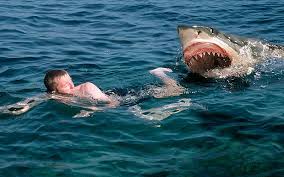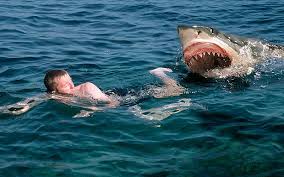
In an effort to curb a rise in attacks that threaten its beach tourism industry, Australia is taking help some of the world’s most advanced shark deterrent technologies and would initiate the program in the next few months.
Plans to test electronic repellents, plastic shields, sonar and other technologies to detect or repel sharks were undertaken after there were nine confirmed deaths in two years from shark attacks.
Globally too there has been an increase in the demand for shark deterrents as more governments and local beach authorities get interested in them after a spate of recent attacks in the US and elsewhere.
The growing popularity of surfing and other water sports, bait fish moving closer to shore or a recovery in large species such as Great White Sharks following conservation efforts are being cited as the possible sudden increase in the number of shark attacks in recent months in various parts of the world.
“We are seeing a lot of interest in our products from divers and spear fishermen due to these attacks,” said Lindsay Lyon, managing director of Shark Shield, a company based in Perth, Western Australia.
A device that emits an electrical field that disturbs the gel-filled sacs in sharks’ snouts, causing them to spasm has been developed by Shark Shield. This device is able to create a field surrounding a swimmer measuring several feet when divers, swimmers or surfers attach the 1.8m long antenna-like device to their ankle when they venture into the sea.
Most shark species, including Tiger and Great White sharks have been found to be significantly affected and deterred by the instrument in tests conducted by researchers at the University of Western Australia.
The bulky nature of the Shark Shield has prevented adoption of the product so far. However the company expects the popularity of the shield to increase as it has signed a deal with surfing equipment company Oceans & Earth to embed the device within boards.
Research originating in South Africa, a country also trialling deterrent technologies has been the basis of the development of Shark Shield’s technology.
A 100m long cable, which emits a similar low frequency pulsed electronic signal to repel Great White sharks, was installed in last year at a beach in Cape Town by the KwaZulu-Natal Sharks Board.
The systems of electronic battery barriers would be preferable to deploying shark nets, say advocates of electronic barriers, arguing that shark nets kill marine life that become entangled.
“Shark nets are another way of culling sharks and marine life. It is similar to setting drum lines and baited hooks,” said Daniel Bucher, marine ecologist at Southern Cross University.
Following community protests, the Western Australia state government last year, ditched a shark cull policy using baited hooks and drum lines. The authorities have now sought alternatives with an Eco Shark Barrier at Coogee beach.
“The beauty of the product is it doesn’t kill marine life, it’s cost effective and has a 10-year lifespan,” said Craig Moss, inventor of the Eco Shark Barrier.
Other forms of technologically advanced electronic shark deterrent include the Clever Buoy system, developed by Shark Attack Mitigation Systems (SAMS), a Western Australian company, that deploys sonar technology around beaches and uses software to analyse readings to determine if a shark-sized object has entered the vicinity.
(Source:www.ft.com)
Plans to test electronic repellents, plastic shields, sonar and other technologies to detect or repel sharks were undertaken after there were nine confirmed deaths in two years from shark attacks.
Globally too there has been an increase in the demand for shark deterrents as more governments and local beach authorities get interested in them after a spate of recent attacks in the US and elsewhere.
The growing popularity of surfing and other water sports, bait fish moving closer to shore or a recovery in large species such as Great White Sharks following conservation efforts are being cited as the possible sudden increase in the number of shark attacks in recent months in various parts of the world.
“We are seeing a lot of interest in our products from divers and spear fishermen due to these attacks,” said Lindsay Lyon, managing director of Shark Shield, a company based in Perth, Western Australia.
A device that emits an electrical field that disturbs the gel-filled sacs in sharks’ snouts, causing them to spasm has been developed by Shark Shield. This device is able to create a field surrounding a swimmer measuring several feet when divers, swimmers or surfers attach the 1.8m long antenna-like device to their ankle when they venture into the sea.
Most shark species, including Tiger and Great White sharks have been found to be significantly affected and deterred by the instrument in tests conducted by researchers at the University of Western Australia.
The bulky nature of the Shark Shield has prevented adoption of the product so far. However the company expects the popularity of the shield to increase as it has signed a deal with surfing equipment company Oceans & Earth to embed the device within boards.
Research originating in South Africa, a country also trialling deterrent technologies has been the basis of the development of Shark Shield’s technology.
A 100m long cable, which emits a similar low frequency pulsed electronic signal to repel Great White sharks, was installed in last year at a beach in Cape Town by the KwaZulu-Natal Sharks Board.
The systems of electronic battery barriers would be preferable to deploying shark nets, say advocates of electronic barriers, arguing that shark nets kill marine life that become entangled.
“Shark nets are another way of culling sharks and marine life. It is similar to setting drum lines and baited hooks,” said Daniel Bucher, marine ecologist at Southern Cross University.
Following community protests, the Western Australia state government last year, ditched a shark cull policy using baited hooks and drum lines. The authorities have now sought alternatives with an Eco Shark Barrier at Coogee beach.
“The beauty of the product is it doesn’t kill marine life, it’s cost effective and has a 10-year lifespan,” said Craig Moss, inventor of the Eco Shark Barrier.
Other forms of technologically advanced electronic shark deterrent include the Clever Buoy system, developed by Shark Attack Mitigation Systems (SAMS), a Western Australian company, that deploys sonar technology around beaches and uses software to analyse readings to determine if a shark-sized object has entered the vicinity.
(Source:www.ft.com)





